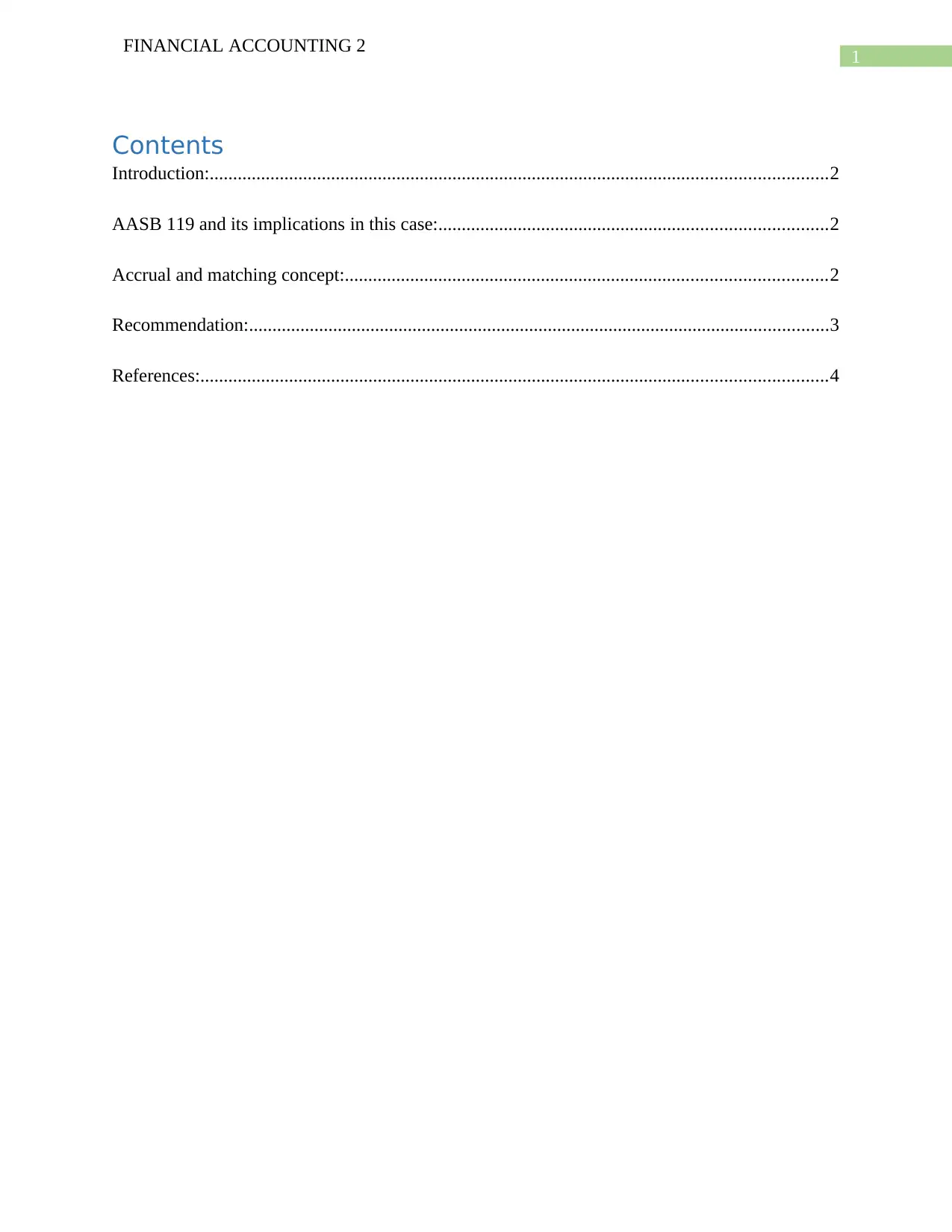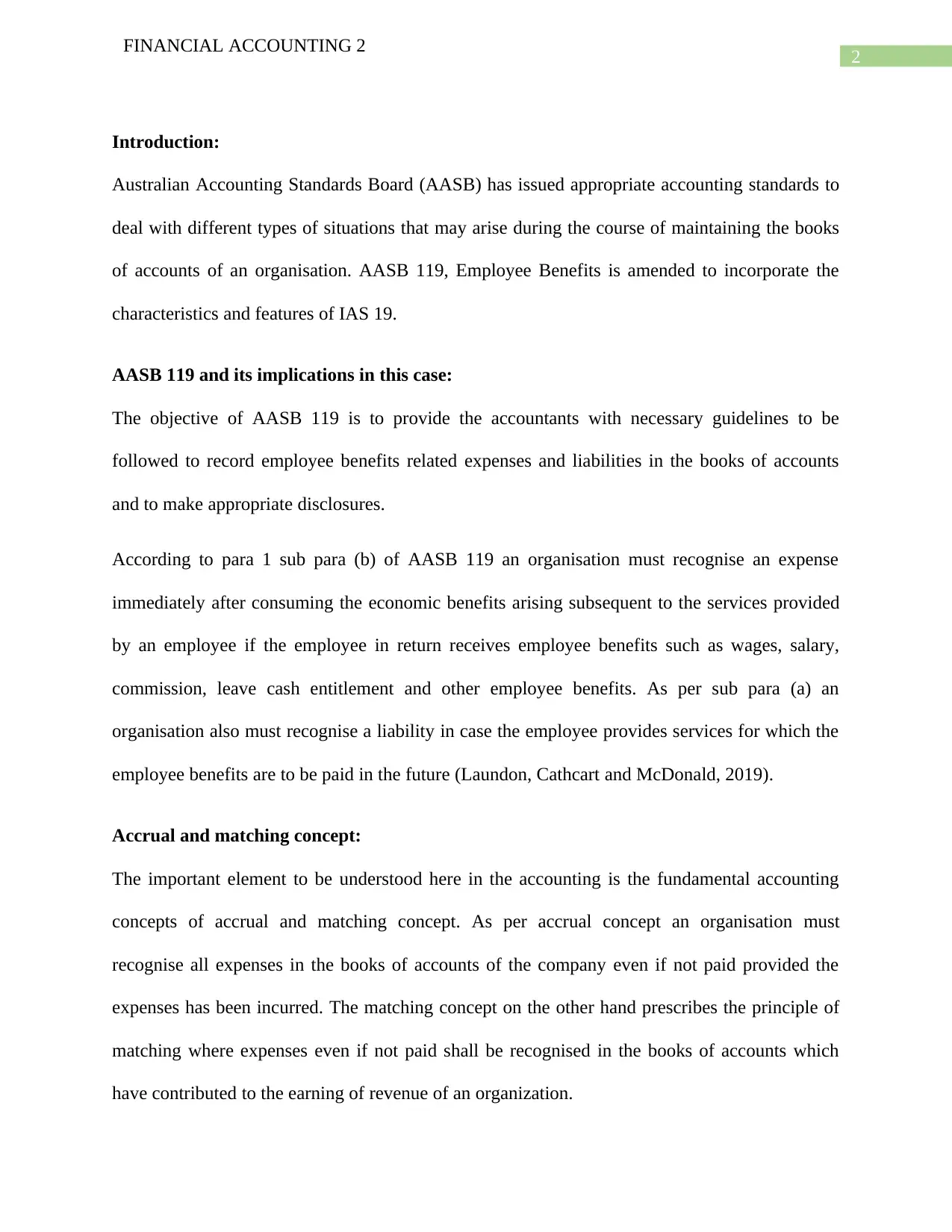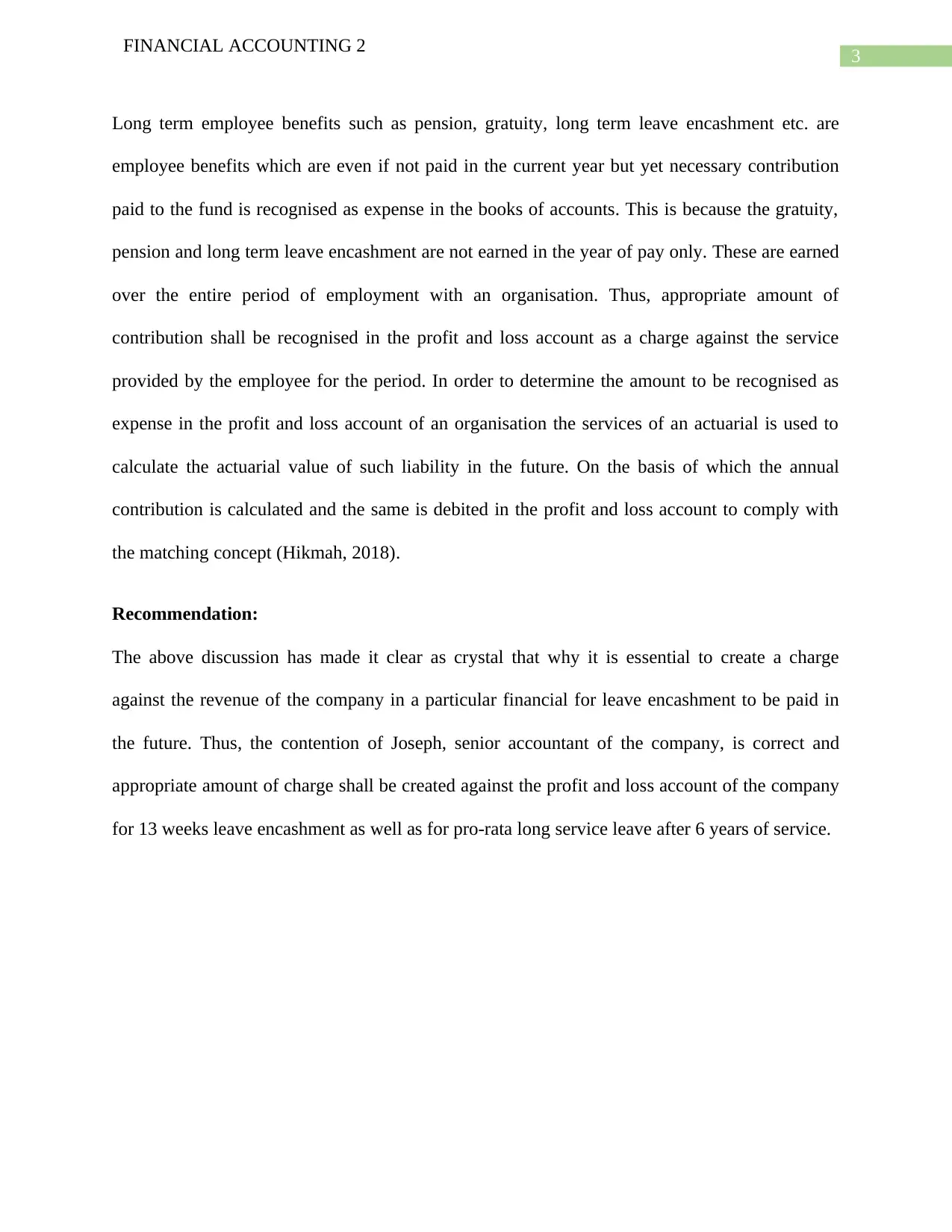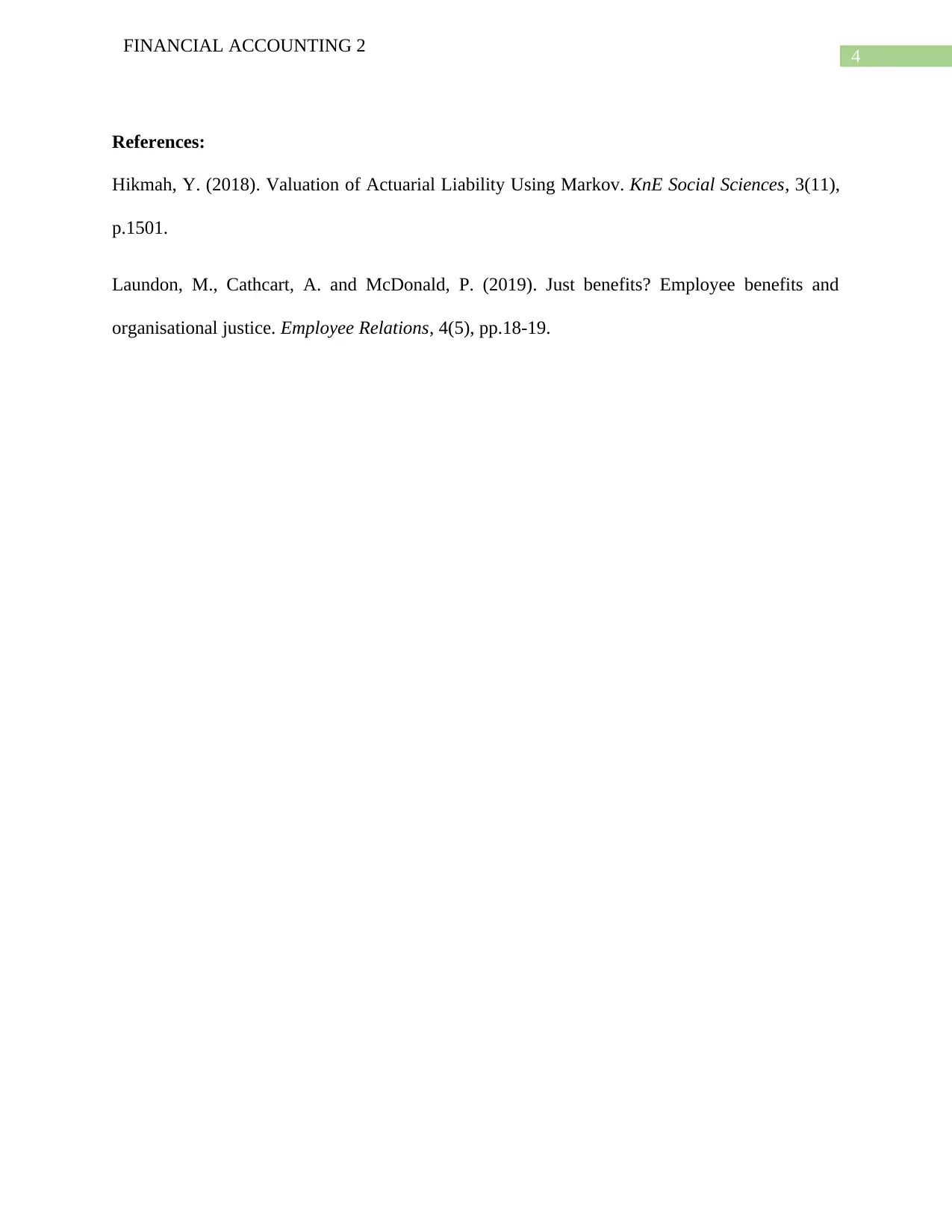Financial Accounting: AASB 119, Employee Benefits and Accrual Concept
VerifiedAdded on 2023/03/31
|5
|603
|455
Report
AI Summary
This report provides an overview of AASB 119 and its implications on accounting for employee benefits, focusing on accrual and matching concepts. It highlights the importance of recognizing employee benefits expenses and liabilities according to AASB 119 guidelines, including long-term benefits like pension, gratuity, and leave encashment. The report emphasizes the role of actuarial valuations in determining the appropriate expense to be recognized in the profit and loss account and supports the senior accountant's view on creating a charge against revenue for future leave encashment liabilities. The document is available on Desklib, a platform offering a wide range of study resources and solved assignments for students.

Running head: FINANCIAL ACCOUNTING 2
Financial Accounting 2
Name of the Student:
Name of the University:
Authors Note:
Financial Accounting 2
Name of the Student:
Name of the University:
Authors Note:
Paraphrase This Document
Need a fresh take? Get an instant paraphrase of this document with our AI Paraphraser

1
FINANCIAL ACCOUNTING 2
Contents
Introduction:....................................................................................................................................2
AASB 119 and its implications in this case:...................................................................................2
Accrual and matching concept:.......................................................................................................2
Recommendation:............................................................................................................................3
References:......................................................................................................................................4
FINANCIAL ACCOUNTING 2
Contents
Introduction:....................................................................................................................................2
AASB 119 and its implications in this case:...................................................................................2
Accrual and matching concept:.......................................................................................................2
Recommendation:............................................................................................................................3
References:......................................................................................................................................4

2
FINANCIAL ACCOUNTING 2
Introduction:
Australian Accounting Standards Board (AASB) has issued appropriate accounting standards to
deal with different types of situations that may arise during the course of maintaining the books
of accounts of an organisation. AASB 119, Employee Benefits is amended to incorporate the
characteristics and features of IAS 19.
AASB 119 and its implications in this case:
The objective of AASB 119 is to provide the accountants with necessary guidelines to be
followed to record employee benefits related expenses and liabilities in the books of accounts
and to make appropriate disclosures.
According to para 1 sub para (b) of AASB 119 an organisation must recognise an expense
immediately after consuming the economic benefits arising subsequent to the services provided
by an employee if the employee in return receives employee benefits such as wages, salary,
commission, leave cash entitlement and other employee benefits. As per sub para (a) an
organisation also must recognise a liability in case the employee provides services for which the
employee benefits are to be paid in the future (Laundon, Cathcart and McDonald, 2019).
Accrual and matching concept:
The important element to be understood here in the accounting is the fundamental accounting
concepts of accrual and matching concept. As per accrual concept an organisation must
recognise all expenses in the books of accounts of the company even if not paid provided the
expenses has been incurred. The matching concept on the other hand prescribes the principle of
matching where expenses even if not paid shall be recognised in the books of accounts which
have contributed to the earning of revenue of an organization.
FINANCIAL ACCOUNTING 2
Introduction:
Australian Accounting Standards Board (AASB) has issued appropriate accounting standards to
deal with different types of situations that may arise during the course of maintaining the books
of accounts of an organisation. AASB 119, Employee Benefits is amended to incorporate the
characteristics and features of IAS 19.
AASB 119 and its implications in this case:
The objective of AASB 119 is to provide the accountants with necessary guidelines to be
followed to record employee benefits related expenses and liabilities in the books of accounts
and to make appropriate disclosures.
According to para 1 sub para (b) of AASB 119 an organisation must recognise an expense
immediately after consuming the economic benefits arising subsequent to the services provided
by an employee if the employee in return receives employee benefits such as wages, salary,
commission, leave cash entitlement and other employee benefits. As per sub para (a) an
organisation also must recognise a liability in case the employee provides services for which the
employee benefits are to be paid in the future (Laundon, Cathcart and McDonald, 2019).
Accrual and matching concept:
The important element to be understood here in the accounting is the fundamental accounting
concepts of accrual and matching concept. As per accrual concept an organisation must
recognise all expenses in the books of accounts of the company even if not paid provided the
expenses has been incurred. The matching concept on the other hand prescribes the principle of
matching where expenses even if not paid shall be recognised in the books of accounts which
have contributed to the earning of revenue of an organization.
⊘ This is a preview!⊘
Do you want full access?
Subscribe today to unlock all pages.

Trusted by 1+ million students worldwide

3
FINANCIAL ACCOUNTING 2
Long term employee benefits such as pension, gratuity, long term leave encashment etc. are
employee benefits which are even if not paid in the current year but yet necessary contribution
paid to the fund is recognised as expense in the books of accounts. This is because the gratuity,
pension and long term leave encashment are not earned in the year of pay only. These are earned
over the entire period of employment with an organisation. Thus, appropriate amount of
contribution shall be recognised in the profit and loss account as a charge against the service
provided by the employee for the period. In order to determine the amount to be recognised as
expense in the profit and loss account of an organisation the services of an actuarial is used to
calculate the actuarial value of such liability in the future. On the basis of which the annual
contribution is calculated and the same is debited in the profit and loss account to comply with
the matching concept (Hikmah, 2018).
Recommendation:
The above discussion has made it clear as crystal that why it is essential to create a charge
against the revenue of the company in a particular financial for leave encashment to be paid in
the future. Thus, the contention of Joseph, senior accountant of the company, is correct and
appropriate amount of charge shall be created against the profit and loss account of the company
for 13 weeks leave encashment as well as for pro-rata long service leave after 6 years of service.
FINANCIAL ACCOUNTING 2
Long term employee benefits such as pension, gratuity, long term leave encashment etc. are
employee benefits which are even if not paid in the current year but yet necessary contribution
paid to the fund is recognised as expense in the books of accounts. This is because the gratuity,
pension and long term leave encashment are not earned in the year of pay only. These are earned
over the entire period of employment with an organisation. Thus, appropriate amount of
contribution shall be recognised in the profit and loss account as a charge against the service
provided by the employee for the period. In order to determine the amount to be recognised as
expense in the profit and loss account of an organisation the services of an actuarial is used to
calculate the actuarial value of such liability in the future. On the basis of which the annual
contribution is calculated and the same is debited in the profit and loss account to comply with
the matching concept (Hikmah, 2018).
Recommendation:
The above discussion has made it clear as crystal that why it is essential to create a charge
against the revenue of the company in a particular financial for leave encashment to be paid in
the future. Thus, the contention of Joseph, senior accountant of the company, is correct and
appropriate amount of charge shall be created against the profit and loss account of the company
for 13 weeks leave encashment as well as for pro-rata long service leave after 6 years of service.
Paraphrase This Document
Need a fresh take? Get an instant paraphrase of this document with our AI Paraphraser

4
FINANCIAL ACCOUNTING 2
References:
Hikmah, Y. (2018). Valuation of Actuarial Liability Using Markov. KnE Social Sciences, 3(11),
p.1501.
Laundon, M., Cathcart, A. and McDonald, P. (2019). Just benefits? Employee benefits and
organisational justice. Employee Relations, 4(5), pp.18-19.
FINANCIAL ACCOUNTING 2
References:
Hikmah, Y. (2018). Valuation of Actuarial Liability Using Markov. KnE Social Sciences, 3(11),
p.1501.
Laundon, M., Cathcart, A. and McDonald, P. (2019). Just benefits? Employee benefits and
organisational justice. Employee Relations, 4(5), pp.18-19.
1 out of 5
Related Documents
Your All-in-One AI-Powered Toolkit for Academic Success.
+13062052269
info@desklib.com
Available 24*7 on WhatsApp / Email
![[object Object]](/_next/static/media/star-bottom.7253800d.svg)
Unlock your academic potential
Copyright © 2020–2025 A2Z Services. All Rights Reserved. Developed and managed by ZUCOL.





